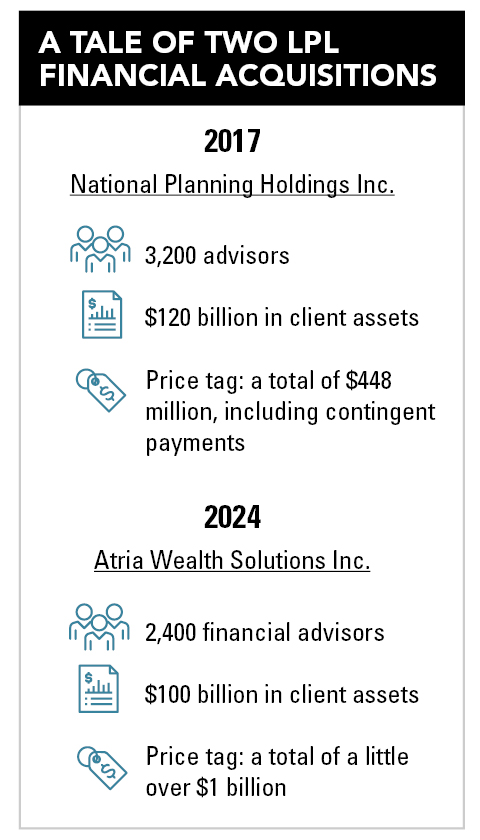

Some not-so-fancy math shows that the value of wealth management companies, meaning broker-dealers and registered investment advisors, has risen dramatically in the past seven years, perhaps as much as doubling what a firm could be worth over that period. That means that the financial advisors and various investors who own firms, from small RIAs to giant broker-dealers, are making out like bandits when and if they decide to sell.
Now for the simple math that underscores the dramatic rise in wealth management firm valuations.
Just take a gander at two deals engineered by LPL Financial Holdings Inc., the first in the summer of 2017 and the second earlier this year. On the surface, they appear extremely similar when it comes to number of financial advisors and the assets those advisors control. But the great difference is the price.
In August 2017, LPL Financial purchased National Planning Holdings Inc., an independent broker-dealer network with 3,200 advisors working with $120 billion in client assets. The initial price tag was $325 million, with a contingent payment of up to $123 million depending on the level of advisors and revenue that moved to LPL, for a total of $448 million.
Jump forward to this February. LPL said it was buying the broker-dealer network Atria Wealth Solutions Inc., with 2,400 financial advisors whose clients have $100 billion in assets. The cost of the deal? An up-front value of $805 million, with up to another $230 million based on retention, or keeping advisors in their place, totaling a little more than $1 billion.
While not an apples-to-apples comparison, the two networks of financial advisors have enough similarities to show that valuations for wealth management firms, depending on the quality of the earnings and cash flow metrics, have certainly risen substantially in the last seven years and weathered the COVID-19 pandemic and recent rise in interest rates.
Meanwhile, the broad stock market has practically doubled over that same period of time, demonstrating the link between wealth management firms that gather assets and the broad market. At the end of 2017, the S&P 500 closed at 2674. As of April 24, the index was trading at 5063, an increase of 89 percent. The S&P 500's high was on March 28, hitting 5265, an increase of 97 percent from the end of 2017.

LPL, a persistent buyer of broker-dealers for the past 20 years, is pleased with the increase in valuations, although it means deals are more expensive. “The value of these wealth management businesses has increased in line with the broader market,” said Christopher Cassidy, LPL’s senior vice president of institutions, in a recent interview. “We are really bullish on this industry.”
Of course, the success of LPL Financial Holdings Inc.’s initial public offering back in 2010 has proven a substantial motivation for private equity funds to jump into the broker-dealer or RIA aggregation market. LPL’s initial public offering was priced at $30 per share; on April 24, LPL shares were trading above $266.
“Ten years ago, broker-dealers had a price of, say, 60 percent of annual revenue,” said Larry Roth, managing partner at RLR Strategic Partners. “Now, the bigger ones are priced at 100 percent of one-year revenues, plus retention for advisors of another 20 percent. Obviously, valuations have held up well, even against the backdrop of increasing interest rates, which make financing more expensive.”
“The key is the continued movement to fee-based revenue, which is annualized, from one-time commission charges,” Roth said. “That’s driving up the values of these firms, along with the price the financial advisor is charging.”
“That’s in the neighborhood of 80 to 85 basis points, and has held up better than expected,” he added. “And larger firms are thinking and betting that clients will stay long term, beyond the career of the financial advisor.”
RIAs and broker-dealers, of course, are not identical businesses, with broker-dealers typically having more financial advisors and generating fees and revenue from marketing agreements with asset management companies and other sources. Still, investors like private equity firms have increasingly moved to combine or aggregate RIAs over the past seven to ten years, and these larger businesses are gaining in value.
“These RIAs and aggregators are growing into big business, and the notion of a billion-dollar valuation is increasingly entering the conversation,” said Peter Nesvold, partner at Republic Capital Group. “Recently, a lot of the usual big RIA suspects have been recapitalizing at valuations north of $1 billion.”
“Remember, this was a cottage industry before the financial crisis, back in 2007 and 2008,” Nesvold said. “Back then, a big firm had $3 billion to $5 billion in client assets, or perhaps $10 billion in assets. Now, we’re seeing an astronomical [level] of assets at firms – $100 billion is becoming more common – and the consolidation of these firms is also increasing as financial advisors and assets continue to move out of the wirehouses.”
A key cash-flow metric for RIAs is EBITDA, or earnings before interest, taxes, depreciation and amortization. RIAs are commonly valued as a multiple of EBITDA.
“There was a period not too long ago when 10 times EBITDA for a $3 billion-in-assets firm was attractive,” Nesvold said. “Now, it’s up to 15 times EBITDA. We’ve seen a 50 percent increase in valuations over the past ten years.”

Elsewhere in Utah, Raymond James also welcomed another experienced advisor from D.A. Davidson.

A federal appeals court says UBS can’t force arbitration in a trustee lawsuit over alleged fiduciary breaches involving millions in charitable assets.

NorthRock Partners' second deal of 2025 expands its Bay Area presence with a planning practice for tech professionals, entrepreneurs, and business owners.

Rather than big projects and ambitious revamps, a few small but consequential tweaks could make all the difference while still leaving time for well-deserved days off.

Hadley, whose time at Goldman included working with newly appointed CEO Larry Restieri, will lead the firm's efforts at advisor engagement, growth initiatives, and practice management support.
Orion's Tom Wilson on delivering coordinated, high-touch service in a world where returns alone no longer set you apart.
Barely a decade old, registered index-linked annuities have quickly surged in popularity, thanks to their unique blend of protection and growth potential—an appealing option for investors looking to chart a steadier course through today's choppy market waters, says Myles Lambert, Brighthouse Financial.
